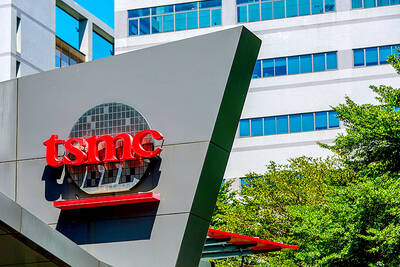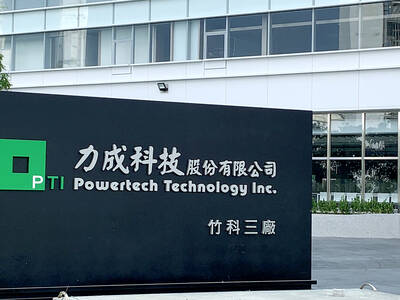After staging a robust rebound a day earlier, the stock market shed 45.3 points, or 0.85 percent, to 5,246.26 at the end of trading yesterday on the back of Wall Street’s fall, analysts said.
Turnover remained light at NT$53.35 billion (US$1.65 billion), with foreign investors buying a net NT$1.18 billion in local shares, compared with a net sale of NT$1.52 billion by domestic investment trust companies, stock exchange data showed.
The local bourse opened at 5,225.05 and fluctuated between 5,246.26 and 5,178.68 during the trading day. Government intervention in the last minutes of trading was believed to have narrowed the fall.
Eric Lai (賴建承), an analyst at Marbo Securities Consultant Co (萬寶證券投顧), said the TAIEX’s performance was closely tied to US equities. The Dow Jones Industrial Average had dipped 76 points, or 0.8 percent, on Tuesday on poor showings by major US high tech companies, Lai said.
Over 200 listed companies, including Taiwan Semiconductor Manufacturing Co (台積電), closed limit down 3.5 percent, stock exchange data showed.
Two of the eight main stock categories gained ground, with the construction sector the best performer, up 3.3 percent, and Lai attributed the rise to a successful auction on Tuesday of the leasing rights to state-owned land in the upscale Xinyi District (信義) of Taipei.
“The transaction helped boost investors’ confidence in the real estate market,” Lai said by telephone. “The planned cut in inheritance and gift taxes was also positive news.”
Looking ahead, Lai said that as long as the US stock market regained stability, the local bourse would witness more rallies, such as on Monday when the TAIEX rallied 271.12 points, or 5.4 percent.
The analyst said he was not worried that the index would suffer a sharp slump after the 3.5 percent daily limit expires at the end of the week.
“The measure is to blame for the thin trading,” Lai said. “While helpful in curbing the size of falls, it also serves to dampen investors’ willingness to enter the equity market.”
Also See: Crisis: Avoiding the Western trap、 Markets slump as recession fears grow、 US financial crisis hits third-quarter shipments of PCs

The DBS Foundation yesterday announced the launch of two flagship programs, “Silver Motion” and “Happier Caregiver, Healthier Seniors,” in partnership with CCILU Ltd, Hondao Senior Citizens’ Welfare Foundation and the Garden of Hope Foundation to help Taiwan face the challenges of a rapidly aging population. The foundation said it would invest S$4.91 million (US$3.8 million) over three years to foster inclusion and resilience in an aging society. “Aging may bring challenges, but it also brings opportunities. With many Asian markets rapidly becoming super-aged, the DBS Foundation is working with a regional ecosystem of like-minded partners across the private, public and people sectors

Taiwan Semiconductor Manufacturing Co (TSMC, 台積電) has secured three construction permits for its plan to build a state-of-the-art A14 wafer fab in Taichung, and is likely to start construction soon, the Central Taiwan Science Park Bureau said yesterday. Speaking with CNA, Wang Chun-chieh (王俊傑), deputy director general of the science park bureau, said the world’s largest contract chipmaker has received three construction permits — one to build a fab to roll out sophisticated chips, another to build a central utility plant to provide water and electricity for the facility and the other to build three office buildings. With the three permits, TSMC

BREAKTHROUGH TECH: Powertech expects its fan-out PLP system to become mainstream, saying it can offer three-times greater production throughput Chip packaging service provider Powertech Technology Inc (力成科技) plans to more than double its capital expenditures next year to more than NT$40 billion (US$1.31 billion) as demand for its new panel-level packaging (PLP) technology, primarily used in chips for artificial intelligence (AI) applications, has greatly exceeded what it can supply. A significant portion of the budget, about US$1 billion, would be earmarked for fan-out PLP technology, Powertech told investors yesterday. Its heavy investment in fan-out PLP technology over the past 10 years is expected to bear fruit in 2027 after the technology enters volume production, it said, adding that the tech would

YEAR-END BOOST: The holiday shopping season in the US and Europe, combined with rising demand for AI applications, is expected to drive exports to a new high, the NDC said Taiwan’s business climate monitor improved last month, transitioning from steady growth for the first time in five months, as robust global demand for artificial intelligence (AI) products and new iPhone shipments boosted exports and corporate sales, the National Development Council (NDC) said yesterday. The council uses a five-color system to measure the nation’s economic state, with “green” indicating steady growth, “red” suggesting a boom and “blue” reflecting a recession. “Yellow-red” and “yellow-blue” suggest a transition to a stronger or weaker condition. The total score of the monitor’s composite index rose to 35 points from a revised 31 in August, ending a four-month